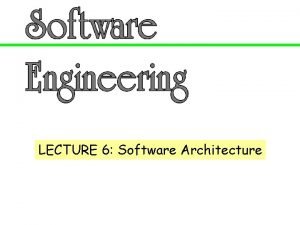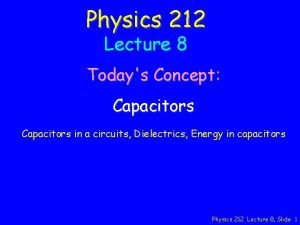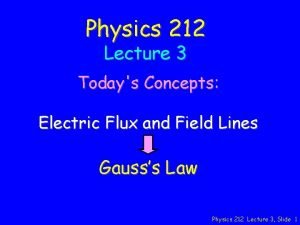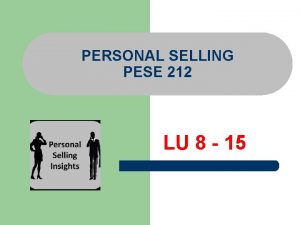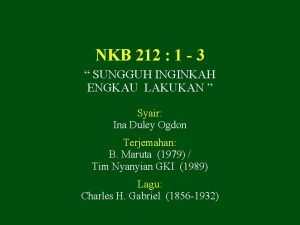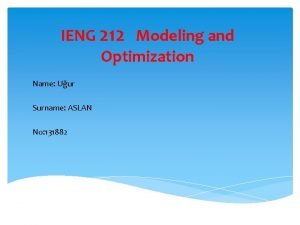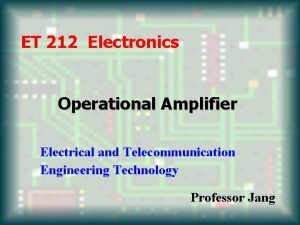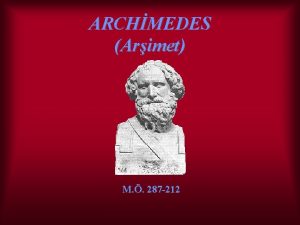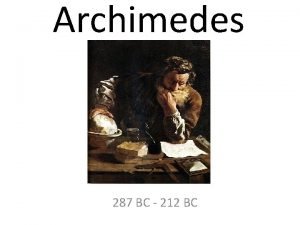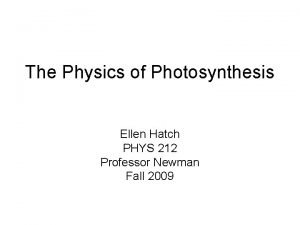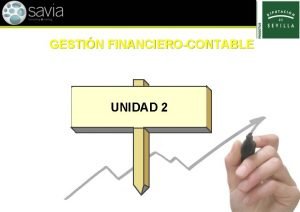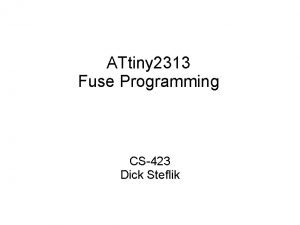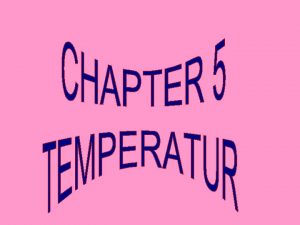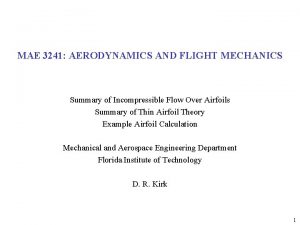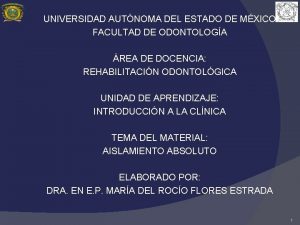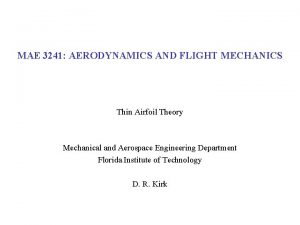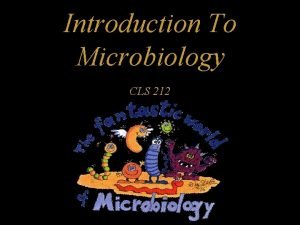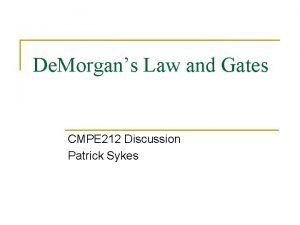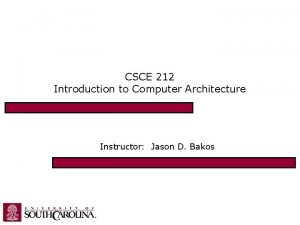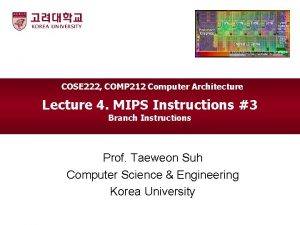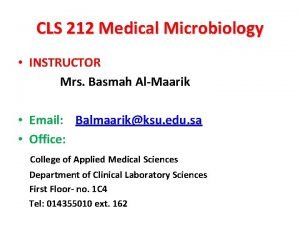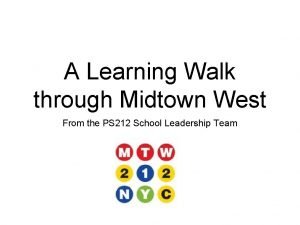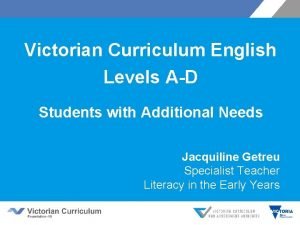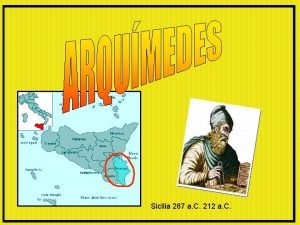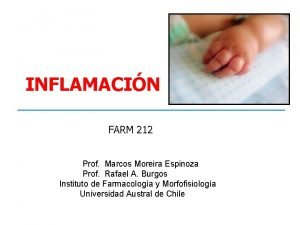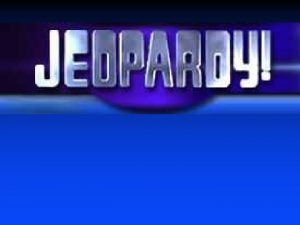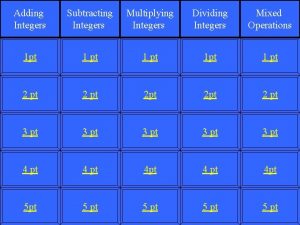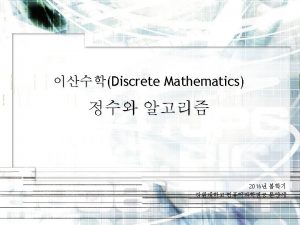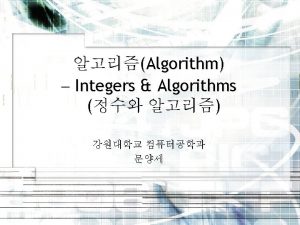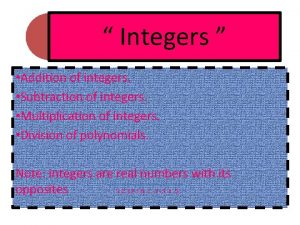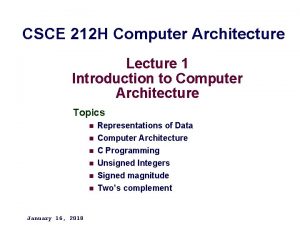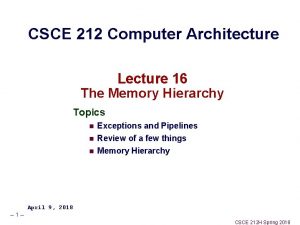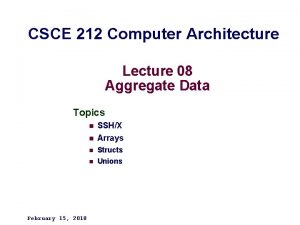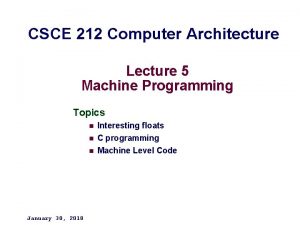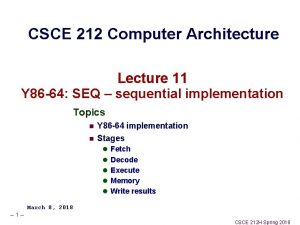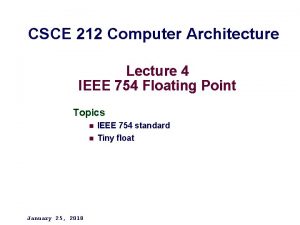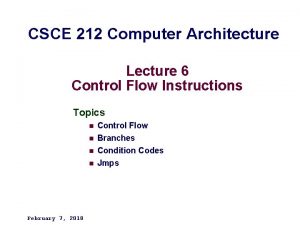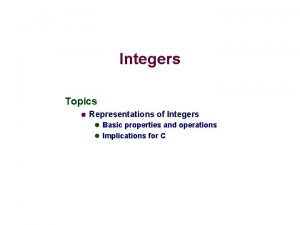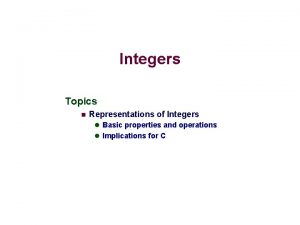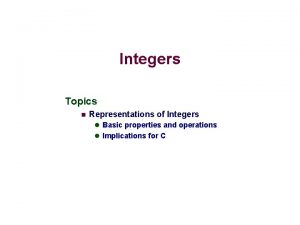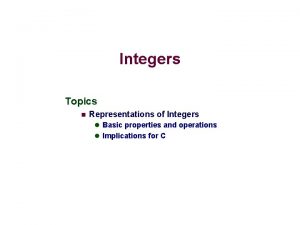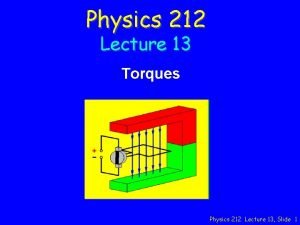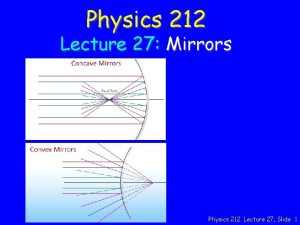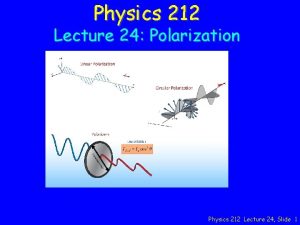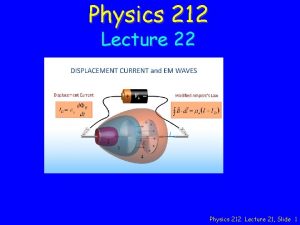CSCE 212 Computer Architecture Lecture 2 Integers Topics



































- Slides: 35

CSCE 212 Computer Architecture Lecture 2 Integers Topics n n n January 16, 2018 Login in SWGN 1 D 39, a Linux Lab (3 D 22 is another) Code-all. tgz (all the code from the book) Basic Unix Commands

Overview • Last Time – Lec 01 slides 1 -? • Course Pragmatics n n n Website http: //www. cse. sc. edu/~matthews/Courses/212/index. html Text - "Computer Systems: A Programmer's Perspective" 3 rd ed Ints are not integers; floats are not reals; unsigned are Z mod 2 w • Today n n Slides 29 - from Lec 01 Two’s Complement formal notation Two’s Complement representation (from text) -1 on highest bit Two’s Complement representation (take 2) l To represent a positive number - same as signed – 2 – magnitude l To represent a negative number – take two’s complement of magnitude CSCE 212 H Spring 2018

Review – Values represented by int Representations • Unsigned • Signed Magnitude • 2’s complement – 3 – CSCE 212 H Spring 2018

Sign Extension • Task: n Given w-bit signed integer x n Convert it to w+k-bit integer with same value • Rule: n n Make k copies of sign bit: X = xw– 1 , …, xw– 1 , xw– 2 , …, x 0 w k copies of MSB X • • • X – 4 – • • • k • • • w CSCE 212 H Spring 2018

Sign Extension Example short int x = 15213; int ix = (int) x; short int y = -15213; int iy = (int) y; x ix y iy Decimal 15213 -15213 Hex 3 B 00 00 3 B C 4 FF FF C 4 6 D 6 D 93 93 Binary 00111011 00000000 00111011 11000100 11111111 11000100 01101101 10010011 • Converting from smaller to larger integer data type • C automatically performs sign extension – 5 – CSCE 212 H Spring 2018

Summary: Expanding, Truncating: Basic Rules • Expanding (e. g. , short int to int) n Unsigned: zeros added n Signed: sign extension Both yield expected result n • Truncating (e. g. , unsigned to unsigned short) n n n – 6 – Unsigned/signed: bits are truncated Result reinterpreted Unsigned: mod operation Signed: similar to mod For small numbers yields expected behavior CSCE 212 H Spring 2018

Unsigned Addition u • • • +v u+v UAddw(u , v) • • • Operands: w bits True Sum: w+1 bits Discard Carry: w bits • Standard Addition Function n Ignores carry output • Implements Modular Arithmetic s = – 7 – UAddw(u , v) = u + v mod 2 w CSCE 212 H Spring 2018

Visualizing (Mathematical) Integer Addition Add 4(u , v) • Integer Addition n 4 -bit integers u, v n Compute true sum Add 4(u , v) n Values increase linearly with u and v Forms planar surface n v u – 8 – CSCE 212 H Spring 2018

Visualizing Unsigned Addition Overflow • Wraps Around n If true sum ≥ 2 w n At most once UAdd 4(u , v) True Sum 2 w+1 Overflow 2 w 0 – 9 – v Modular Sum u CSCE 212 H Spring 2018

Two’s Complement Addition Operands: w bits True Sum: w+1 bits Discard Carry: w bits u • • • + v u+v • • • TAddw(u , v) • • TAdd and UAdd have Identical Bit-Level Behavior n Signed vs. unsigned addition in C: int s, t, u, v; s = (int) ((unsigned) u + (unsigned) v); t = u + v n – 10 – Will give s == t CSCE 212 H Spring 2018

TAdd Overflow True Sum • Functionality n n n – 11 – True sum requires w+1 bits Drop off MSB Treat remaining bits as 2’s comp. integer 0 111… 1 0 100… 0 2 w– 1 Pos. Over 2 w – 1– 1 TAdd Result 011… 1 0 000… 0 1 011… 1 – 2 w – 1 100… 0 1 000… 0 – 2 w Neg. Over CSCE 212 H Spring 2018

Visualizing 2’s Complement Addition Neg. Over • Values n 4 -bit two’s comp. n Range from -8 to +7 TAdd 4(u , v) • Wraps Around n If sum 2 w– 1 l Becomes negative l At most once n l Becomes – 12 – v If sum < – 2 w– 1 positive l At most once u Pos. Over CSCE 212 H Spring 2018

Multiplication • Goal: Computing Product of w-bit numbers x, y n Either signed or unsigned • But, exact results can be bigger than w bits n Unsigned: up to 2 w bits l Result range: 0 ≤ x * y ≤ (2 w – 1) 2 = 22 w – 2 w+1 + 1 n Two’s complement min (negative): Up to 2 w-1 bits l Result range: x * y ≥ (– 2 w– 1)*(2 w– 1– 1) = – 22 w– 2 + 2 w – 1 n Two’s complement max (positive): Up to 2 w bits, but only for (TMinw)2 l Result range: x * y ≤ (– 2 w– 1) 2 = 22 w– 2 • So, maintaining exact results… – 13 – n would need to keep expanding word size with each product CSCE 212 H Spring 2018 computed

Unsigned Multiplication in C Operands: w bits True Product: 2*w bits u·v u • • • * v • • • UMultw(u , v) Discard w bits: w bits • Standard Multiplication Function n Ignores high order w bits • Implements Modular Arithmetic UMultw(u , v) – 14 – = u · v mod 2 w CSCE 212 H Spring 2018

Signed Multiplication in C u * v Operands: w bits True Product: 2*w bits u·v Discard w bits: w bits • • • TMultw(u , v) • • • • Standard Multiplication Function n – 15 – Ignores high order w bits Some of which are different for signed vs. unsigned multiplication Lower bits are the same CSCE 212 H Spring 2018

Power-of-2 Multiply with Shift • Operation n u << k gives u * 2 k n Both signed and unsigned u * 2 k Operands: w bits True Product: w+k bits Discard k bits: w bits k u · 2 k • • • 0 • • • 0 1 0 • • • 0 0 • • • UMultw(u , 2 k) TMultw(u , 2 k) • • • • Examples n u << 3 == u * 8 (u << 5) – (u << 3)== u * 24 n Most machines shift and add faster than multiply n – 16 – l Compiler generates this code automatically CSCE 212 H Spring 2018

Unsigned Power-of-2 Divide with Shift • Quotient of Unsigned by Power of 2 n u >> k gives u / 2 k n Uses logical shift Operands: Division: Result: – 17 – u • • • k • • • / 2 k u / 2 k 0 • • • 0 1 0 • • • 0 0 • • • u / 2 k 0 • • • 0 0 • • • Binary Point 0 0. • • • CSCE 212 H Spring 2018

Arithmetic: Basic Rules • Addition: n n Unsigned/signed: Normal addition followed by truncate, same operation on bit level Unsigned: addition mod 2 w l Mathematical addition + possible subtraction of 2 w n Signed: modified addition mod 2 w (result in proper range) l Mathematical addition + possible addition or subtraction of 2 w • Multiplication: n – 18 – n Unsigned/signed: Normal multiplication followed by truncate, same operation on bit level Unsigned: multiplication mod 2 w CSCE 212 H Spring 2018

Why Should I Use Unsigned? • Don’t use without understanding implications n Easy to make mistakes unsigned i; for (i = cnt-2; i >= 0; i--) a[i] += a[i+1]; n Can be very subtle #define DELTA sizeof(int) int i; for (i = CNT; i-DELTA >= 0; i-= DELTA). . . – 19 – CSCE 212 H Spring 2018

Counting Down with Unsigned • Proper way to use unsigned as loop index unsigned i; for (i = cnt-2; i < cnt; i--) a[i] += a[i+1]; • See Robert Seacord, Secure Coding in C and C++ n C Standard guarantees that unsigned addition will behave like modular arithmetic l 0 – 1 UMax • Even better size_t i; for (i = cnt-2; i < cnt; i--) a[i] += a[i+1]; n – 20 – n Data type size_t defined as unsigned value with length = word size CSCE 212 H Spring 2018 Code will work even if cnt = UMax

Why Should I Use Unsigned? (cont. ) • Do Use When Performing Modular Arithmetic n Multiprecision arithmetic • Do Use When Using Bits to Represent Sets n – 21 – Logical right shift, no sign extension CSCE 212 H Spring 2018

Byte-Oriented Memory Organization F • • 0 0 • • • F • • • F • Programs refer to data by address n Conceptually, envision it as a very large array of bytes l In reality, it’s not, but can think of it that way n An address is like an index into that array l and, a pointer variable stores an address • Note: system provides private address spaces to each “process” n Think of a process as a program being executed CSCE 212 H Spring 2018 So, a program can clobber its own data, but not that of others – 22 – n

Machine Words • Any given computer has a “Word Size” n Nominal size of integer-valued data l and of addresses n Until recently, most machines used 32 bits (4 bytes) as word size l Limits addresses to 4 GB (232 bytes) n Increasingly, machines have 64 -bit word size l Potentially, could have 18 PB (petabytes) of addressable memory l That’s 18. 4 X 1015 – 23 –n Machines still support multiple data formats CSCE 212 H Spring 2018

Word-Oriented Memory Organization • Addresses Specify Byte Locations n n Address of first byte in word Addresses of successive words differ by 4 (32 -bit) or 8 (64 -bit) 32 -bit 64 -bit Words Addr = 0000 ? ? Addr = 0004 ? ? Addr = 0008 ? ? Addr = 0012 ? ? – 24 – Addr = 0000 ? ? Addr = 0008 ? ? Bytes Addr. 0000 0001 0002 0003 0004 0005 0006 0007 0008 0009 0010 0011 0012 0013 0014 0015 CSCE 212 H Spring 2018

Example Data Representations C Data Type – 25 – Typical 32 -bit Typical 64 -bit x 86 -64 char 1 1 1 short 2 2 2 int 4 4 4 long 4 8 8 float 4 4 4 double 8 8 8 long double − − 10/16 pointer 4 8 8 CSCE 212 H Spring 2018

Byte Ordering • So, how are the bytes within a multi-byte word ordered in memory? • Conventions n Big Endian: Sun, PPC Mac, Internet l Least significant byte has highest address n Little Endian: x 86, ARM processors running Android, i. OS, and Windows l Least significant byte has lowest address – 26 – CSCE 212 H Spring 2018

Byte Ordering Example • Example n Variable x has 4 -byte value of 0 x 01234567 n Address given by &x is 0 x 100 Big Endian Little Endian – 27 – 0 x 100 0 x 101 0 x 102 0 x 103 01 23 45 67 0 x 100 0 x 101 0 x 102 0 x 103 67 45 23 01 CSCE 212 H Spring 2018

Representing Integers Binary: Decimal: 15213 Hex: int A = 15213; IA 32, x 86 -64 6 D 3 B 00 00 Sun 00 00 3 B 6 D int B = -15213; IA 32, x 86 -64 93 C 4 FF FF – 28 – Sun FF FF C 4 93 0011 1011 0110 1101 3 B 6 D long int C = 15213; IA 32 6 D 3 B 00 00 x 86 -64 Sun 6 D 3 B 00 00 3 B 6 D Two’s complement representation CSCE 212 H Spring 2018

Examining Data Representations • Code to Print Byte Representation of Data n Casting pointer to unsigned char * allows treatment as a byte array typedef unsigned char *pointer; void show_bytes(pointer start, size_t len){ size_t i; for (i = 0; i < len; i++) printf(”%pt 0 x%. 2 xn", start+i, start[i]); printf("n"); } Printf directives: %p: Print pointer %x: Print Hexadecimal – 29 – CSCE 212 H Spring 2018

show_bytes Execution Example int a = 15213; printf("int a = 15213; n"); show_bytes((pointer) &a, sizeof(int)); Result (Linux x 86 -64): int a = 15213; 0 x 7 fffb 7 f 71 dbc 0 x 7 fffb 7 f 71 dbd 0 x 7 fffb 7 f 71 dbe 0 x 7 fffb 7 f 71 dbf – 30 – 6 d 3 b 00 00 CSCE 212 H Spring 2018

Representing Pointers int B = -15213; int *P = &B; Sun IA 32 x 86 -64 EF AC 3 C FF 28 1 B FB F 5 FE 2 C FF 82 FD 7 F 00 00 Different compilers & machines assign different locations to objects – 31 – CSCE 212 H Spring 2018

Representing Strings • Strings in C n Represented by array of characters n Each character encoded in ASCII format n n IA 32 Sun 31 set l Standard 7 -bit encoding of character 31 l Character “ 0” has code 0 x 30 38 38 » Digit i has code 0 x 30+i String should be null-terminated 32 32 31 31 l Final character = 0 33 33 00 00 • Compatibility – 32 – char S[6] = "18213"; Byte ordering not an issue CSCE 212 H Spring 2018

Integer C Puzzles Initialization int x = foo(); int y = bar(); unsigned ux = x; unsigned uy = y; – 33 – • • • • x < 0 �� ux >= 0 x & 7 == 7 �� ux > -1 x > y �� x * x >= 0 x > 0 && y > 0 �� x >= 0 �� x <= 0 �� (x|-x)>>31 == -1 ux >> 3 == ux/8 x >> 3 == x/8 x & (x-1) != 0 ((x*2) < 0) (x<<30) < 0 -x < -y x + y > 0 -x <= 0 -x >= 0 CSCE 212 H Spring 2018

Application of Boolean Algebra • Applied to Digital Systems by Claude Shannon n 1937 MIT Master’s Thesis n Reason about networks of relay switches l Encode closed switch as 1, open switch as 0 A&~B A Connection when ~B A&~B | ~A&B ~A&B – 34 – = A^B CSCE 212 H Spring 2018

– 35 – CSCE 212 H Spring 2018
 Computer architecture lecture notes
Computer architecture lecture notes Isa vs microarchitecture
Isa vs microarchitecture 01:640:244 lecture notes - lecture 15: plat, idah, farad
01:640:244 lecture notes - lecture 15: plat, idah, farad 3 bus architecture
3 bus architecture Difference between architecture and organisation
Difference between architecture and organisation Basic computer organization and design
Basic computer organization and design Software architecture topics
Software architecture topics Q=vc physics
Q=vc physics Physics 212 gradebook
Physics 212 gradebook Pese 212
Pese 212 Sungguh inginkah engkau lakukan
Sungguh inginkah engkau lakukan Ienf 212
Ienf 212 Et 212
Et 212 Et 212
Et 212 12345 6789 10
12345 6789 10 Archimedes ( arşimet) (mö 287–212 )
Archimedes ( arşimet) (mö 287–212 ) Archimedes (287-212 bc)
Archimedes (287-212 bc) Phys 212 equation sheet
Phys 212 equation sheet 212 instalaciones tecnicas ejemplos
212 instalaciones tecnicas ejemplos Ckdiv
Ckdiv X:3=212
X:3=212 Hubungan antara suhu dan pemuaian benda
Hubungan antara suhu dan pemuaian benda Naca 63-212
Naca 63-212 Arco visframe e hygenic
Arco visframe e hygenic Cls 212
Cls 212 Naca 63-212
Naca 63-212 Disadvantages of fermentation
Disadvantages of fermentation Cmpe 212
Cmpe 212 212
212 212
212 Cls 212
Cls 212 Ps 212 midtown west
Ps 212 midtown west Ables curriculum
Ables curriculum Garra de arquímedes
Garra de arquímedes Classification of pneumonia
Classification of pneumonia Permeabilidad vascular
Permeabilidad vascular






